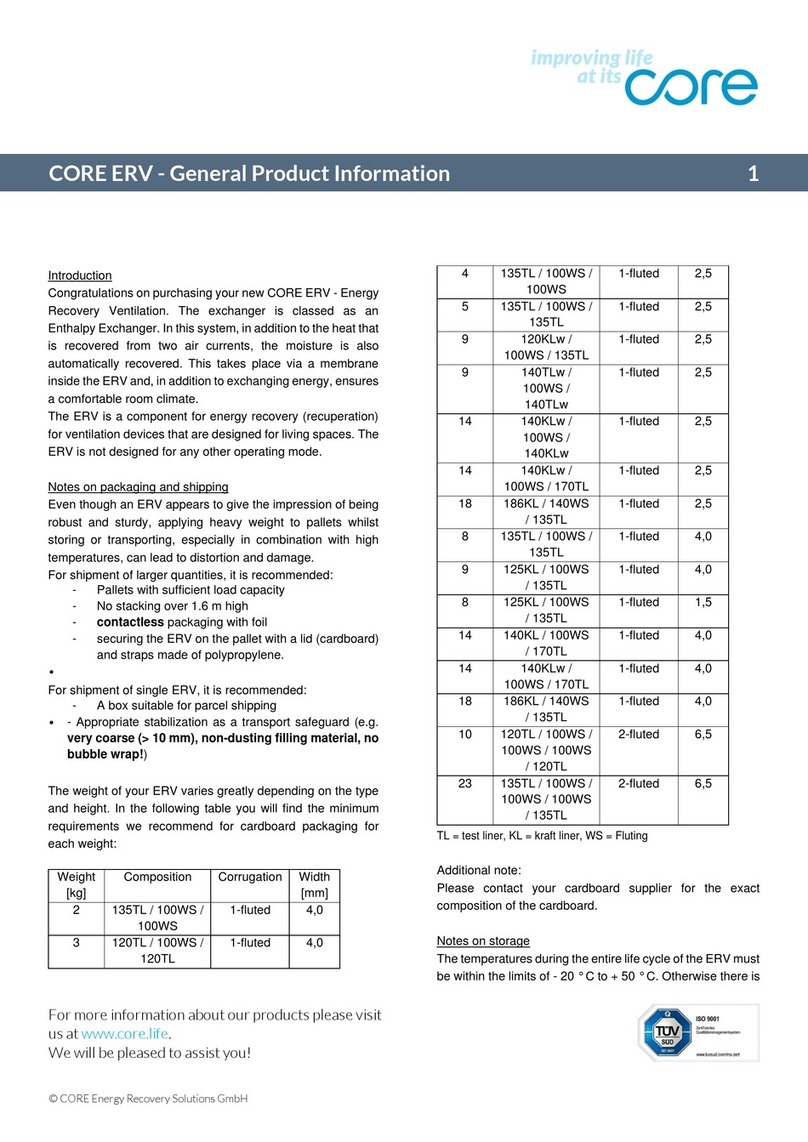Your ventilation unit manufacturer will inform you about the
corresponding settings.
If you carry out renovation work, use strong cleaners or
oils for floors and furniture or other chemicals, including
biologically produced, biodegradable and bio-based
chemicals, in quantities > 50 ml, we recommend removing
the HRV from the ventilation unit, switching off the
ventilation unit and, at least for the time of work, better
still a few days to a week afterwards and to ventilate the
affected area extensively with open windows and doors.
In this way, you avoid the transfer of odours (see chapter
Odour) and possible damage to the material, which cannot be
restored using the recommended cleaning procedure. The
influence of chemicals can reduce the high technical
performance of your HRV.
The HRV is not designed for applications in areas with a high
chemical load, including workshops and production halls. The
HRV may only be used in office and living areas!
The temperatures during the entire life cycle of the HRV must
be within the limits of - 20 ° C to + 50 ° C. Otherwise there is
a risk of distortion, odour formation and the occurrence of
leaks. All of this reduces the high performance of your HRV.
Notes on cleaning
A dirty HRV can be cleaned and disinfected. You can find
detailed information on the washing and disinfection process
in our cleaning instructions.
Notes on disposal
Please dispose of a visibly soiled HRV, which can no longer
be cleaned, as well as adamaged HRV or those that are to be
disposed of for reasons of age by putting them in the
household waste bin.
Notes on shelf life
The HRV will lose a small part of its high technical
performance in the course of its life cycle. This is due to the
aging of the materials and different levels of environmental
influences. The composition of the airflows have a strong
influence on the aging of the HRV, which is why the HRV is
only designed for residential areas.
An HRV can be operated for up to 10 years without
interruption if the conditions under the instructions for
handling, use and storage are complied with. In the case of
storage, the storage time is deducted from the specified 10
years of operation life. The 10 years start from the date of
manufacture (see type plate on the HRV).
Notes on materials
The HRV consists largely of high-quality polystyrene and a
small part of adhesive and sealing material. Some HRV
types have a metal housingand / or additionalaluminum side
grilles instead of the plastic housing, which do not affect the
performance.
Some of the adhesives used are permanently sticky, which
is why sticky surfaces or stickiness inside may still occur.
This is not an indication of reduced quality or a
manufacturing defect.
Notes on conformities / certificates / standards
Our HRV comply to the following conformities / certificates /
standards:
Hygiene standard: DIN ISO 846
Fire standard: EN DIN 13501, ISO 11925 (Class
E)
Quality management: DIN ISO 9001:2015
Notes on odour
An HRV consists exclusively of non-metabolizable plastics,
tested in compliance with the hygiene standard VDI 6022 -
DIN ISO 846. However, if you suspect mould and/or bacterial
infestation, please follow the necessary steps for disinfecting
according to the cleaning instructions for HRV.
In addition to the odours caused by microorganisms, other
odours may arise when using an HRV. Please find here the





















